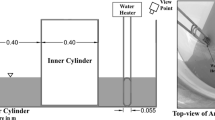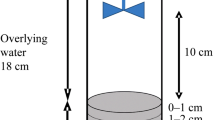Abstract
Evaporation of trichloroethylene (TCE) is a viable option in the remediation of TCE contaminated water. In this study, laboratory batch experiments were conducted to understand the evaporation kinetics of TCE in surface water, with further extension of this knowledge to field application. Experiments were set up for 15, 30, 60, and 90 min time intervals in open glass containers with initial concentration of 10 mgl−1 TCE in 100 ml water. The containers were either exposed to wind or were placed on an orbital shaker to produce constant water motion. A reference study carried out in absence of wind and water-motion showed much slower rate of TCE evaporation, compared to other studies done with wind or orbital shaker. Experiments with water turbulence at 150 rpm yielded a higher volatilization coefficient, Kv = 4.36 h−1 for TCE. The wind at a flow rate of 0.7 m/s also gave rise to 2.24 h−1 coefficient for TCE evaporation. The volatilization coefficient for the reference study yielded a smaller value of 0.23 h−1, with corresponding half-life of 3 h, indicating the importance of wind and water motion in TCE evaporation. Experiments conducted at 150rpm and 0.7 m/s wind velocity showed consistent evaporation trend, and were in better agreement with the extrapolated rate of evaporation obtained through the first order rate equation.






Similar content being viewed by others
References
Beltran, F. J., Gonzalez, M., Rivas, F. J., & Jaramillo, J. (1995). Application of photochemical reactor models to UV irradiation of trichloroethylene in water. Chemosphere, 31(3), 2873–2885.
Bennett, J. P., & Rathbun, R. E. (1972). Reaeration in open channel flow. USGS Professional Paper 737.
Bianchi, A. P., & Varney, M. S. (1997). Volatilization processes in wastewater treatment plants as a source of potential exposure to VOCs. Annals of Occupational Hygiene, 41(4), 437–454.
Brewer, K. E., & Fogle, T. L. (2001). Uncertainty analysis for the southern TCE plume in the C-Area Groundwater Operable Unit (U). WSRC-RP-2001-4201, 1–13.
Brigmon, R., McKinsey, P., Phifer, M., Rossabi, J., Looney, B., & Heitkamp, M. (2001). Accelerated microbial attenuation of trichloroethylene at C-Burning Rubber Pit and D-Area. WSRC-TR-2001, 2–10.
Chiao, F. F., Currie, R. C., McKone, T. E. (1994). Intermedia transfer factors for contaminants found at hazardous waste sites: Trichloroethylene (TCE). Final draft report, Risk Science Program, Department of Environmental Toxicology, University of California.
Churchill, M. A., Elmore, H. L., & Buckingham, R. A. (1962). The prediction of stream reaeration rates. Journal of the Sanitary Engineering Division, American Society of Civil Engineering, 88(SA4), 1–46.
Cohen, Y., Cocchio, W., & Mackay, D. (1978). Laboratory study of liquid-phase controlled volatilization rates in presence of wind waves. Environmental Science & Technology, 12(5), 553–558.
Dilling, W. L., Tefertiller, N. B., & Kallos, G. J. (1975). Evaporation rates and reactivities of methylene chloride, chloroform, 1,1,1-trichloroethane, trichloroethylene, tetrachloroethylene, and other chlorinated compounds in dilute aqueous solutions. Environmental Science & Technology, 9(9), 833–838.
Ebadian, M. A., Pant, P., Katsenovich, Y., Oztruk, Z., Jayachandran, K., & Cai, Y. (2003). Determination of natural attenuation mechanisms and kinetics. Year-end technical progress report for the fiscal year 2003. Prepared for U.S. Department of Energy-Office of Environmental Management, Office of Science and Technology, Grant No. DE-FG26-00NT40806.
Hamond, H. F., & Fechner-Levy, E. J. (2000). Chemical fate and transport in the environment, 2nd edn. California, USA: Academic.
Hill IV, J., Kolling, H. P., Paris, D. F., Wolfe, N. L., & Zepp, R. G. (1976). Dynamic behavior of vinyl chloride in aquatic ecosystems. U.S. Environmental Protection Agency (EPA)-600/3-76-001.
Isaacs, W. P., & Gaudy, A. F. (1968). Atmospheric oxygenation in a simulated stream. Journal of the Sanitary Engineering Division, ASCE, 94(SA2) paper 5905 319.
Kotzias, D., & Sparta, C. (1993). VOCs and water pollution. In H. J. M. Bloemen & J. Burn (Eds.), Chemistry and analysis of volatile organic compounds in the environment (pp. 175–199). London: Blackie Academic.
Langbein, W. B., & Durum, W. H. (1967). The aeration capacity of streams. U.S. Geological Survey, Circular No. 542, Reston, Va.
Liss, P. S., & Slater, P. G. (1974). Flux of gases across the air–sea interface. Nature (London), 247, 181–184.
Mackay, D. (1977). Volatilization of pollutants from water. In E. O. Hutzinger, I. H. Van Lelyveld, & B. C. J. Zoetemans (Eds.), Aquatic pollutants: Transformation and biological effects, Proceedings of the 2nd International Symposium on aquatic pollutants. The Netherlands: Amsterdam (September 26–28).
Mackay, D., & Leinonen, P. J. (1975). Rate of evaporation of low solubility contaminants from water bodies to atmosphere. Environmental Science & Technology, 9, 1178–1180.
Mackay, D., Shiu, W. Y., & Sutherland, R. P. (1979). Determination of air–water Henry’s law constants for hydrophobic pollutants. Environmental Science & Technology, 13, 333–337.
Mackay, D., & Wolkoff, A. W. (1973). Rate of evaporation of low solubility contaminants from water bodies to atmosphere. Environmental Science & Technology, 7, 611–614.
Marrin, D. L., & Kerfoot, H. B. (1988). Soil–gas surveying techniques. Environmental Science & Technology, 22(7), 740–745.
Metcalf and Eddy, Inc (2003). Wastewater engineering: Treatment and reuse, 4th edn. New Delhi, India: McGraw-Hill.
Negelescu, M., & Rojanski, V. (1969). Recent research to determine reaeration coefficients. Water Research, 3(3), 189–202.
O’Connor, D. J., & Dobbins, W. E. (1958). Mechanism of reaeration in natural streams. Transactions of the American Society of Civil Engineers, 123, 641–666.
Owens, M., Edwards, R. W., & Gibbs, J. W. (1964). Some reaeration studies in streams. International Journal of Air and Water Pollution, 8(8/9), 469–486.
Rathbun, R. E. (2000) Transport, behavior, and fate of volatile organic compounds in streams. Critical Reviews in Environmental Science and Technology, 30(2), 129–295.
Riley, R. G., & Zachara, J. M. (1992). Chemical contaminants on DOE lands and selection of contaminant mixtures for subsurface science research. U.S. DOE Office of Energy Research-Subsurface Science Program, pp. 3–5.
Schettler, T., Solomon, G., Valenti, M., & Huddle, A. (1999). Generations at risk: Reproductive health and the environment (pp. 52–53). Cambridge, Massachusetts: MIT Press.
Smith, J. H., & Bomberger, D. C. (1979). Prediction of volatilization rates of chemicals in water. Water:1978, AIChE Symposium Series, 190, 75, 375–381.
Smith, J. H., Bomberger Jr., D. C., & Haynes, D. L. (1980). Prediction of volatilization rates of high-volatility chemicals from natural water bodies. Environmental Science & Technology, 14(11), 1332–1337.
Spitz, K. H., & Moreno, J. (1996). A practical guide to ground water and solute transport modeling. New York: Wiley.
Stocking, A. J., & Kavanaugh, M. C. (2000). Modeling volatilization of MTBE from standing surface waters. Journal of Environmental Engineering, 126(12), 1131–1136.
Thackston, E. L., Krenkel, P. A. (1969). Reaeration prediction in natural streams. American Socociety of Civil Engineering, Journal of the Sanitary Engineering Division, 95(SA-1), 65–94.
Tsivoglou, E. C. (1967). Tracer measurement of stream reaeration. Washington, D.C.: Federal Water Pollution Control Administration.
United States Environmental Protection Agency (USEPA) (1997). Use of monitored natural attenuation at superfund, RCRA corrective action, and underground storage tank sites. OSWER Directives 9200, 4–17.
U.S. EPA (1998). Technical protocol for evaluating natural attenuation of chlorinated solvents in ground water. EPA/600/R-98/128, 1–10.
Acknowledgements
The authors would like to, acknowledge the support of United States Department of Energy for their financial assistance for the completion of this work. This work was a task carried out for the Savannah River Operations Office under grant No. DE-RP0902SR22229.
Author information
Authors and Affiliations
Corresponding author
Rights and permissions
About this article
Cite this article
Pant, P., Allen, M., Cai, Y. et al. Influence of Physical Factors on Trichloroethylene Evaporation from Surface Water. Water Air Soil Pollut 183, 153–163 (2007). https://doi.org/10.1007/s11270-007-9365-5
Received:
Accepted:
Published:
Issue Date:
DOI: https://doi.org/10.1007/s11270-007-9365-5




